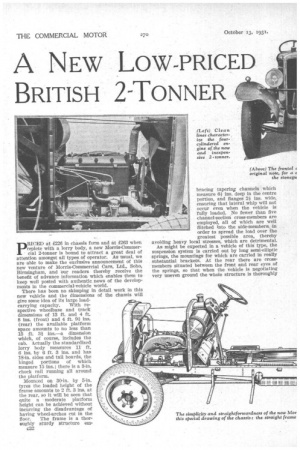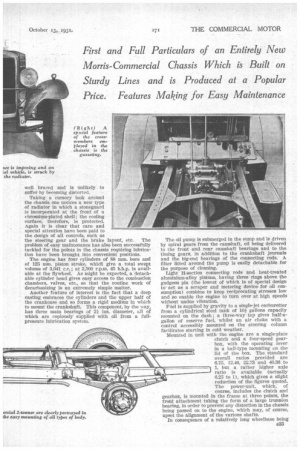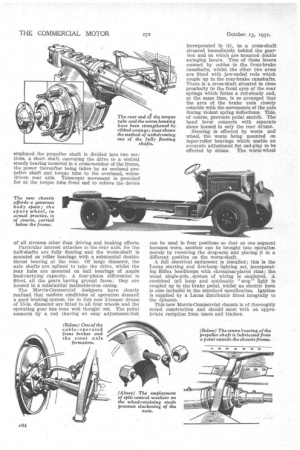A NEW LOW-PRICED BRITISH 2-TONNER
Page 54

Page 55

Page 56

If you've noticed an error in this article please click here to report it so we can fix it.
First and Full Particulars of an Entirely New Morris-Commercial Chassis Which is Built on Sturdy Lines and is Produced at a Popular Price. Features Making for Easy Maintenance
RICED at £226 in chassis form and at £263 when replete with a lorry body, a new Morris-Commer cial 2-tonner is bound to attract a great deal of attention amongst all types of operator. As usual, we are able to make the exclusive announcement of this new venture of Morris-Commercial Cars, Ltd., Soho, Birmingham, and our readers thereby receive the benefit of advance information which enables them to keep well posted with authentic news of the developments in the commercial-vehicle world.
There has been no skimping in detail work in this new vehicle and the dimensions of the chassis will give some idea of its large load
carrying capacity. With respective wheelbase and track dimensions of 13 ft. and 4 ft. 8 ins. (front) and 4 ft. 9i ins. (rear) the available platform space amounts to no less than 15 ft. 3i ins.—a dimension which, of course, includes the cab. A.ctually the standardized lorry body measures 11 ft. 6 ins. by 6 ft. 3 ins, and has 18-in. sides and tail boards, the hinged portions of which measure 15 ins.; there is a 3-in. chock rail running all around the platform.
Mounted on 30-in. by 5-in. tyres the loaded height of the frame amounts to 2 ft. 3 ins, at the rear, so it will be seen that quite a • moderate platform height can be achieved without incurring the disadvantage of having wheel-arches cut in the
floor. The frame is a thoroughly sturdy structure emc32
bracing tapering channels which measure 61 ins. deep In the centre portion, and flanges 21 ins, wide, ensuring that lateral whip will not occur even when the vehicle is fully loaded. No fewer than five channel-section cross-members are employed, all of which are well flitched into the side-members, in order to spread the load over the greatest possible area, thereby avoiding heavy local stresses, Which are detrimental. As might be expected in a vehicle of this type, the suspension system is carried out by long semi-elliptic springs, the mountings for which are carried in really substantial brackets. At the rear there are crossmembers situated between the front and rear eyes of the springs, so that when the vehicle is negotiating very uneven ground the whole structure is thoroughly well braced and is unlikely to suffer by becoming distorted.
Taking a cursory look around the chassis one notices a new type of radiator in which a stoneguard is incorporated at the front of a chromium-plated shell; the cooling surface, therefore, is protected. Again it is clear that care and special attention have been paid to the design of all controls, such as the steering gear and the brake layout, etc. The problem of easy maintenance has also been successfully tackled for the points in the chassis requiring lubrication have been brought into convenient positions.
The engine has four cylinders of 88 mm. bore and of 125 mm. piston stroke, which give a total swept volume of 3,041 c.c.; at 2,500 r.p.m. 45 b.h.p. is available at the flywheel. As might be expected, a detachable cylinder head gives easy access to the combustion chambers, valves, etc., so that the routine work of decarbonizing is an extremely simple matter.
Another feature of interest is the fact that a deep casting embraces the cylinders and the upper half of the crankcase and so forms a rigid medium in which to mount the crankshaft. This component, by the way, has three main bearings of 21 ius, diameter, till of which are copiously supplied with oil from a fullpressure lubrication system. The oil pump is submerged in the sump and is driven by spiral gears from the camshaft, oil being delivered to the front and rear camshaft bearings and to the timing gears, in addition to the crankshaft journals and the big-end bearings of the connecting rods. A filter fitted around the pump is easily detachable for the purpose of cleaning.
Light H-section connecting rods and heat-treated aluminium-alloy pistons, having three rings above the gudgeon pin (the lowest of which is of special design to act as a scraper and metering devicefor oil consumption) combine to keep reciprocating stresses low and so enable the engine to turn over at high speeds without undue vibration.
Fuel is supplied by gravity to a single-jet carburetter from a cylindrical steel tank of l gallons capacity mounted on the dash ; a three-way tap gives half-agallon of reserve fuel, whilst an air choke with a control accessibly mounted on the steering column facilitates starting in cold weather.
Mounted in unit with the engine are a single-plate clutch and a four-speed gearbox, with the operating lever in a ball-type mounting on the lid of the box. The standard overall ratios provided are 6.75, 12.46, 22.73 and 40.36 to 1, but a rather higher axle ratio is available (actually 6.25 to 1), which gives a slight reduction of the figures quoted. The power-unit, which, of
course, includes the clutch and gearbox, is mounted in the frame at three points, the front attachment taking the form of a large trunnion bearing, in order to prevent any distortion in the chassis being passed on to the engine, which may, of course, upset the alignment of the various shafts.
In consequence of a relatively long wheelbase being eS3 employed the propeller shaft is divided into two sections, a short shaft conveying the drive to a central steady bearing mounted in a cross-member of the frame, the power thereafter being taken by an enclosed propeller shaft and torque tube to the overhead, wormdriven rear axle. Telescopic movement is provided for at the torque tube front end to relieve the device of all stresses other than driving and braking efforts.
Particular interest attaches to the rear axle, for the half-shafts are fully floating and the worm-shaft is mounted on roller bearings with a substantial double, thrust bearing at the rear. Of large diameter, the axle shafts are splined to take the drive, whilst the rear hubs are mounted on ball bearings of ample load-carrying capacity. A four-pinion differential is fitted, all the gears having ground faces; they are housed in a substantial malleable-iron casing.
The Morris-Commercial designers have clearly realized that modern conditions of operation demand a good braking system, for in this new 2-tonner drums of I5-in, diameter are fitted to all four wheels and the operating gear has been well thought out. The pedal connects by a rod (having an easy adjustment-link incorporated in it), to a cross-shaft situated immediately behind the gearbox and on which are mounted double swinging levers. Two of these levers connect by cables to the front-brake camshafts, whilst the other two arms are fitted with jaw-ended rods which couple up to the rear-brake camshafts. There is a cross-shaft situated in close proximity to the front eyes of the rear springs which forms a rod-steady and, at the same time, is so arranged that the arcs of the brake rods closely coincide with the movements of the axle during violent spring deflections. This, of course, prevents pedal snatch. The hand lever connects with separate shoes housed in only the rear drums.
Steering is effected by worm and wheel, the worm being mounted on taper-roller bearings which enable an accurate adjustment for end-play to be effected by shims. The worm-wheel can be used in four positions so that as one segment becomes worn, another can be brought into operation merely by removing the drop-arm and placing it in a different position on the worm-shaft.
A full electrical equipment is installed ; this is the Lucas starting and five-lamp lighting set, incorporating Biflex headlamps with chromium-plated rims; the usual single-pole,:system of wiring is employed. A combined tail lamp and automatic " stop " light is coupled up to the brake pedal, whilst an electric horn is also included in the standard specification. Ignition is supplied by a Lucas distributor fitted integrally to the dynamo.
This new Morris-Commercial chassis is of thoroughly sound construction and should meet with an appropriate reception from users and traders.












































































































